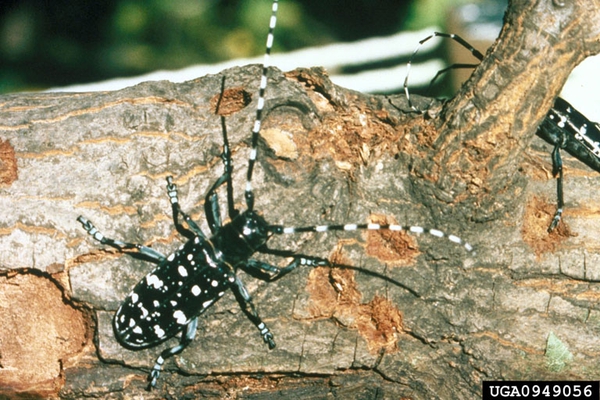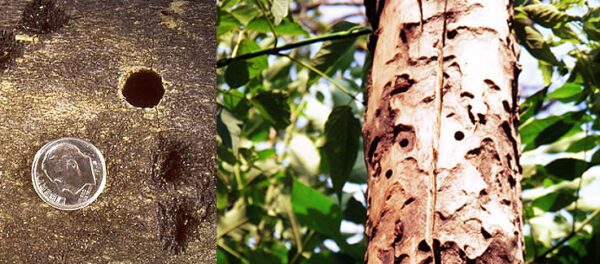Invasive Pests
Invasive pests (plants, insects, diseases, and others) cause enormous economic damage, as well as environmental damage. These displace or destroy beneficial and native plants and animals, reduce biodiversity. The annual economic cost is estimated at $1 billion in VA alone, more than $120 billion in the US.
If you think you see the following pest, which is not yet known to occur in Bedford County, please contact the Bedford Master Gardeners at bedfordmg@vt.edu or 540-586-7675. If you are outside of Bedford County, please contact your local Virginia Cooperative Extension Office.
Invasive Pest #5
Asian Longhorned Beetle (Anoplophora glabripennis)
(Ref 3)

Just the latest of the invasive wood-boring insects, the Asian Longhorned Beetle (ALB) likely arrived via wood shipping materials (e.g., crates, pallets) used to transport goods. First detected in NY in 1996, it since has been found in multiple other states including SC (2020). According to USDA, “The ALB has the potential to cause more damage than Dutch elm disease, chestnut blight and gypsy moths combined, destroying millions of acres of America’s treasured hardwoods, including national forests and backyard trees.” (ref 4)

Known to attack 29 species of hardwood trees, ALB prefers species of maple (Acer spp.) including boxelder, Norway, red, silver, and sugar maples. Other known hosts include alders (Alnus spp.), birches (Betula spp.), elms (Ulmus spp.), horsechestnut (Aesculus spp.), poplars (Populus spp.), sycamore (Platanus spp.), and willows (Salix spp.) (Ref 1, 2, 3)
Adults measure roughly 2-4 cm (0.75-1.5”) long. The antennae are about the length of the female’s body, but twice as long in males. They have numerous white spots of different sizes on the shiny black wing covers. The long antennae have distinctive black and white bands. (Ref 1, 2, 3, 4, 5, 6)
There is one generation per year. Adults are present from July to October, later if temperatures are warm. They usually stay on trees they emerged from or will migrate short distances to find a new host to feed and reproduce.
Larvae tunnel under the bark and feed on living tissue through the fall and winter. They eventually pupate in the wood and emerge through round exit holes the following spring. Adult ALB leave infested wood through exit holes large enough to insert a pencil.
Anyone who sees or suspects ALB should report it immediately to their state plant protection agency. (Ref 1, 4, 5, 6)
Quarantines (state and federal combined) and tree removal are used to control this pest and its spread (Ref 1, 4).
References (confirmed 7/10/2023)
1 https://www.aphis.usda.gov/aphis/ourfocus/planthealth/plant-pest-and-disease-programs/pests-and-diseases/asian-longhorned-beetle/asian-longhorned-beetle
2 https://extension.umd.edu/resource/asian-longhorned-beetle
3 https://content.ces.ncsu.edu/asian-longhorned-beetle
4 https://www.aphis.usda.gov/aphis/resources/pests-diseases/hungry-pests/the-threat/asian-longhorned-beetle/asian-longhorned-beetle
5 https://www.pubs.ext.vt.edu/content/dam/pubs_ext_vt_edu/ENTO/ento-556/ENTO-556.pdf
6 https://www.pubs.ext.vt.edu/content/dam/pubs_ext_vt_edu/ENTO/ento-557/ENTO-557.pdf
Submitted by Betsy B. Extension Master Gardener Volunteer and Help Desk Coordinator.